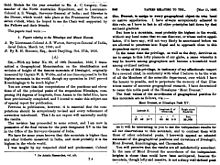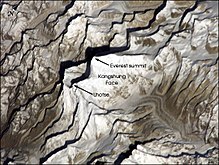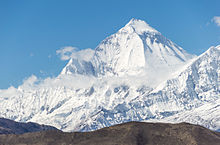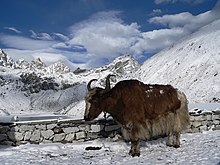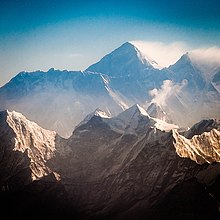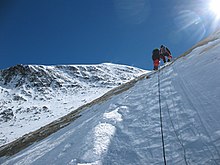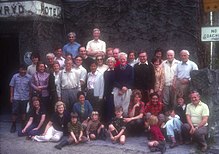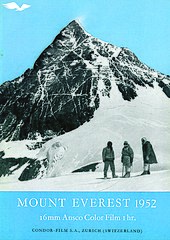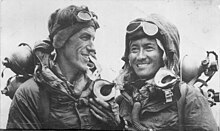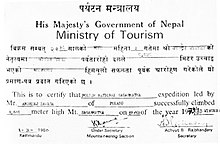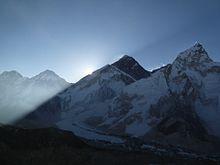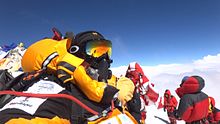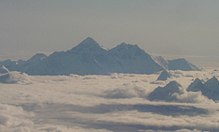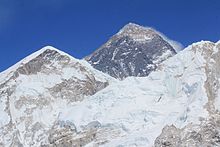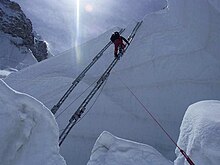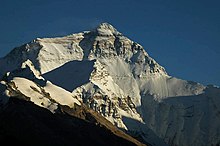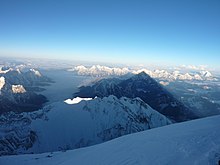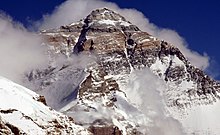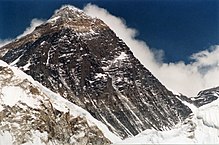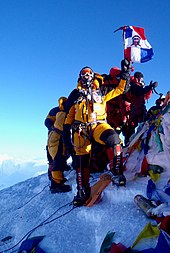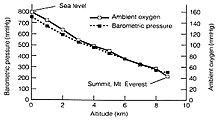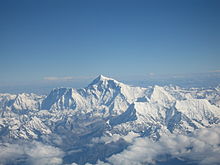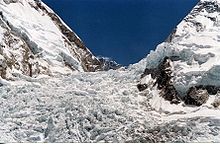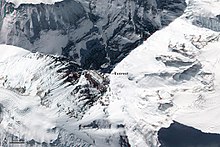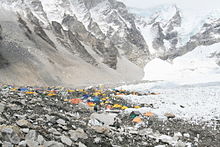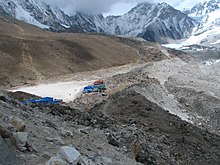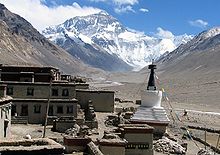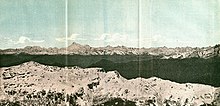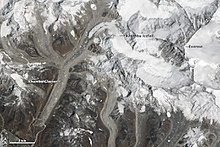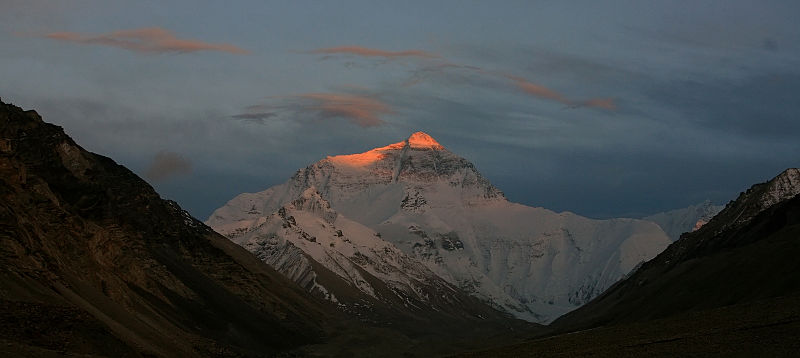Mount Everest
Definition
| Mount Everest | |
|---|---|
| सगरमाथा (Sagarmāthā) ཇོ་མོ་གླང་མ (Chomolungma) 珠穆朗玛峰 (Zhūmùlǎngmǎ Fēng) | |
 Everest's north face from the Tibetan plateau | |
| Highest point | |
| Elevation | 8,848 metres (29,029 ft) Ranked 1st |
| Geography | |
 Location on the Province No. 1, Nepal – Tibet Autonomous Region, China border | |
The current official elevation of 8,848 m (29,029 ft), recognized by China and Nepal, was established by a 1955 Indian survey and subsequently confirmed by a Chinese survey in 1975. In 2005, China remeasured the rock height of the mountain, with a result of 8844.43 m. There followed an argument between China and Nepal as to whether the official height should be the rock height (8,844 m., China) or the snow height (8,848 m., Nepal). In 2010, an agreement was reached by both sides that the height of Everest is 8,848 m, and Nepal recognizes China's claim that the rock height of Everest is 8,844 m.
In 1865, Everest was given its official English name by the Royal Geographical Society, upon a recommendation by Andrew Waugh, the British Surveyor General of India. As there appeared to be several different local names, Waugh chose to name the mountain after his predecessor in the post, Sir George Everest, despite George Everest's objections.
Mount Everest attracts many climbers, some of them highly experienced mountaineers. There are two main climbing routes, one approaching the summit from the southeast in Nepal (known as the "standard route") and the other from the north in Tibet. While not posing substantial technical climbing challenges on the standard route, Everest presents dangers such as altitude sickness, weather, and wind, as well as significant hazards from avalanches and the Khumbu Icefall. As of 2017, nearly 300 people have died on Everest, many of whose bodies remain on the mountain.
The first recorded efforts to reach Everest's summit were made by British mountaineers. As Nepal did not allow foreigners into the country at the time, the British made several attempts on the north ridge route from the Tibetan side. After the first reconnaissance expedition by the British in 1921 reached 7,000 m (22,970 ft) on the North Col, the 1922 expedition pushed the north ridge route up to 8,320 m (27,300 ft), marking the first time a human had climbed above 8,000 m (26,247 ft). Seven porters were killed in an avalanche on the descent from the North Col. The 1924 expedition resulted in one of the greatest mysteries on Everest to this day: George Mallory and Andrew Irvine made a final summit attempt on 8 June but never returned, sparking debate as to whether or not they were the first to reach the top. They had been spotted high on the mountain that day but disappeared in the clouds, never to be seen again, until Mallory's body was found in 1999 at 8,155 m (26,755 ft) on the north face. Tenzing Norgay and Edmund Hillary made the first official ascent of Everest in 1953, using the southeast ridge route. Norgay had reached 8,595 m (28,199 ft) the previous year as a member of the 1952 Swiss expedition. The Chinese mountaineering team of Wang Fuzhou, Gonpo, and Qu Yinhua made the first reported ascent of the peak from the north ridge on 25 May 1960.
History
The history of this area dates back to 800 BCE, when the ancient Kirati had their Kirata Kingdom in the Himalayan mountains . The Mahalangur range of the Himalaya is also known as Kirat area of eastern Nepal.
Early surveys
Location on Earth
In 1715, the Qing Empire surveyed the mountain while mapping its territory and depicted it as Mount Qomolangma no later than 1719.
In 1802, the British began the Great Trigonometric Survey of India to fix the locations, heights, and names of the world's highest mountains. Starting in southern India, the survey teams moved northward using giant theodolites, each weighing 500 kg (1,100 lb) and requiring 12 men to carry, to measure heights as accurately as possible. They reached the Himalayan foothills by the 1830s, but Nepal was unwilling to allow the British to enter the country due to suspicions of political aggression and possible annexation. Several requests by the surveyors to enter Nepal were turned down.
The British were forced to continue their observations from Terai, a region south of Nepal which is parallel to the Himalayas. Conditions in Terai were difficult because of torrential rains and malaria. Three survey officers died from malaria while two others had to retire because of failing health.
Nonetheless, in 1847, the British continued the survey and began detailed observations of the Himalayan peaks from observation stations up to 240 km (150 mi) distant. Weather restricted work to the last three months of the year. In November 1847, Andrew Waugh, the British Surveyor General of India made several observations from the Sawajpore station at the east end of the Himalayas. Kangchenjunga was then considered the highest peak in the world, and with interest, he noted a peak beyond it, about 230 km (140 mi) away. John Armstrong, one of Waugh's subordinates, also saw the peak from a site farther west and called it peak "b". Waugh would later write that the observations indicated that peak "b" was higher than Kangchenjunga, but given the great distance of the observations, closer observations were required for verification. The following year, Waugh sent a survey official back to Terai to make closer observations of peak "b", but clouds thwarted his attempts.
In 1849, Waugh dispatched James Nicolson to the area, who made two observations from Jirol, 190 km (120 mi) away. Nicolson then took the largest theodolite and headed east, obtaining over 30 observations from five different locations, with the closest being 174 km (108 mi) from the peak.
Nicolson retreated to Patna on the Ganges to perform the necessary calculations based on his observations. His raw data gave an average height of 9,200 m (30,200 ft) for peak "b", but this did not consider light refraction, which distorts heights. However, the number clearly indicated that peak "b" was higher than Kangchenjunga. Nicolson contracted malaria and was forced to return home without finishing his calculations. Michael Hennessy, one of Waugh's assistants, had begun designating peaks based on Roman numerals, with Kangchenjunga named Peak IX. Peak "b" now became known as Peak XV.
In 1852, stationed at the survey headquarters in Dehradun, Radhanath Sikdar, an Indian mathematician and surveyor from Bengal, was the first to identify Everest as the world's highest peak, using trigonometriccalculations based on Nicolson's measurements. An official announcement that Peak XV was the highest was delayed for several years as the calculations were repeatedly verified. Waugh began work on Nicolson's data in 1854, and along with his staff spent almost two years working on the numbers, having to deal with the problems of light refraction, barometric pressure, and temperature over the vast distances of the observations. Finally, in March 1856 he announced his findings in a letter to his deputy in Calcutta. Kangchenjunga was declared to be 8,582 m (28,156 ft), while Peak XV was given the height of 8,840 m (29,002 ft). Waugh concluded that Peak XV was "most probably the highest in the world". Peak XV (measured in feet) was calculated to be exactly 29,000 ft (8,839.2 m) high, but was publicly declared to be 29,002 ft (8,839.8 m) in order to avoid the impression that an exact height of 29,000 feet (8,839.2 m) was nothing more than a rounded estimate. Waugh is sometimes playfully credited with being "the first person to put two feet on top of Mount Everest".
Name
While the survey wanted to preserve local names if possible (e.g., Kangchenjunga and Dhaulagiri), Waugh argued that he could not find any commonly used local name. Waugh's search for a local name was hampered by Nepal and Tibet's exclusion of foreigners. Many local names existed, including "Deodungha" ("Holy Mountain") in Darjeeling and the Tibetan "Chomolungma", which appeared on a 1733 map published in Paris by the French geographer D'Anville. In the late 19th century, many European cartographers incorrectly believed that a native name for the mountain was Gaurishankar, a mountain between Kathmandu and Everest.
Waugh argued that because there were many local names, it would be difficult to favour one name over all others, so he decided that Peak XV should be named after Welsh surveyor Sir George Everest, his predecessor as Surveyor General of India. Everest himself opposed the name suggested by Waugh and told the Royal Geographical Society in 1857 that "Everest" could not be written in Hindi nor pronounced by "the native of India". Waugh's proposed name prevailed despite the objections, and in 1865, the Royal Geographical Society officially adopted Mount Everest as the name for the highest mountain in the world. The modern pronunciation of Everest (/ˈɛvərɪst/) is different from Sir George's pronunciation of his surname (/ˈiːvrɪst/EEV-rist).
The Tibetan name for Mount Everest is ཇོ་མོ་གླང་མ (IPA: [t͡ɕʰòmòlɑ́ŋmɑ̀], lit. "Holy Mother"), whose official Tibetan pinyin form is Qomolangma. It is also popularly romanised as Chomolungma and (in Wylie) as Jo-mo-glang-ma or Jomo Langma. The official Chinese transcription is 珠穆朗玛峰 (t 珠穆朗瑪峰), whose pinyin form is Zhūmùlǎngmǎ Fēng. It is also infrequently simply translated into Chinese as Shèngmǔ Fēng (t 聖母峰, s 圣母峰, lit. "Holy Mother Peak"). In 2002, the Chinese People's Daily newspaper published an article making a case against the use of "Mount Everest" in English, insisting that the mountain should be referred to as Mount "Qomolangma", based on the official form of the local Tibetan name. The article argued that British colonialists did not "first discover" the mountain, as it had been known to the Tibetans and mapped by the Chinese as "Qomolangma" since at least 1719.
In the early 1960s, the Nepalese government coined a Nepali name for Mount Everest, Sagarmāthā or Sagar-Matha (सागर-मथ्था).
Surveys
The 8,848 m (29,029 ft) height given is officially recognised by Nepal and China, although Nepal plans a new survey.
In 1856, Andrew Waugh announced Everest (then known as Peak XV) as 8,840 m (29,002 ft) high, after several years of calculations based on observations made by the Great Trigonometric Survey.
The elevation of 8,848 m (29,029 ft) was first determined by an Indian survey in 1955, made closer to the mountain, also using theodolites. It was subsequently reaffirmed by a 1975 Chinese measurement of 8,848.13 m (29,029.30 ft). In both cases the snow cap, not the rock head, was measured. In May 1999 an American Everest Expedition, directed by Bradford Washburn, anchored a GPS unit into the highest bedrock. A rock head elevation of 8,850 m (29,035 ft), and a snow/ice elevation 1 m (3 ft) higher, were obtained via this device. Although it has not been officially recognised by Nepal, this figure is widely quoted. Geoid uncertainty casts doubt upon the accuracy claimed by both the 1999 and 2005 surveys.
A detailed photogrammetric map (at a scale of 1:50,000) of the Khumbu region, including the south side of Mount Everest, was made by Erwin Schneider as part of the 1955 International Himalayan Expedition, which also attempted Lhotse. An even more detailed topographic map of the Everest area was made in the late-1980s under the direction of Bradford Washburn, using extensive aerial photography.
On 9 October 2005, after several months of measurement and calculation, the Chinese Academy of Sciences and State Bureau of Surveying and Mapping officially announced the height of Everest as 8,844.43 m (29,017.16 ft) with accuracy of ±0.21 m (8.3 in). They claimed it was the most accurate and precise measurement to date. This height is based on the highest point of rock and not the snow and ice covering it. The Chinese team also measured a snow-ice depth of 3.5 m (11 ft), which is in agreement with a net elevation of 8,848 m (29,029 ft). The snow and ice thickness varies over time, making a definitive height of the snow cap impossible to determine.
It is thought that the plate tectonics of the area are adding to the height and moving the summit northeastwards. Two accounts suggest the rates of change are 4 mm (0.16 in) per year (upwards) and 3 to 6 mm (0.12 to 0.24 in) per year (northeastwards), but another account mentions more lateral movement (27 mm or 1.1 in),and even shrinkage has been suggested.
Comparisons
The summit of Everest is the point at which earth's surface reaches the greatest distance above sea level. Several other mountains are sometimes claimed to be the "tallest mountains on earth". Mauna Kea in Hawaii is tallest when measured from its base; it rises over 10,200 m (33,464.6 ft) when measured from its base on the mid-ocean floor, but only attains 4,205 m (13,796 ft) above sea level.
By the same measure of base to summit, Denali, in Alaska, also known as Mount McKinley, is taller than Everest as well. Despite its height above sea level of only 6,190 m (20,308 ft), Denali sits atop a sloping plain with elevations from 300 to 900 m (980 to 2,950 ft), yielding a height above base in the range of 5,300 to 5,900 m (17,400 to 19,400 ft); a commonly quoted figure is 5,600 m (18,400 ft). By comparison, reasonable base elevations for Everest range from 4,200 m (13,800 ft) on the south side to 5,200 m (17,100 ft) on the Tibetan Plateau, yielding a height above base in the range of 3,650 to 4,650 m (11,980 to 15,260 ft).
The summit of Chimborazo in Ecuador is 2,168 m (7,113 ft) farther from earth's centre (6,384.4 km (3,967.1 mi)) than that of Everest (6,382.3 km (3,965.8 mi)), because the earth bulges at the equator. This is despite Chimborazo having a peak 6,268 m (20,564.3 ft) above sea level versus Mount Everest's 8,848 m (29,028.9 ft).
Geology
Geologists have subdivided the rocks comprising Mount Everest into three units called formations. Each formation is separated from the other by low-angle faults, called detachments, along which they have been thrust southward over each other. From the summit of Mount Everest to its base these rock units are the Qomolangma Formation, the North ColFormation, and the Rongbuk Formation.
The Qomolangma Formation, also known as the Jolmo Lungama Formation or the Everest Formation, runs from the summit to the top of the Yellow Band, about 8,600 m (28,200 ft) above sea level. It consists of greyish to dark grey or white, parallel laminated and bedded, Ordovician limestone interlayered with subordinate beds of recrystallised dolomite with argillaceous laminae and siltstone. Gansser first reported finding microscopic fragments of crinoids in this limestone.Later petrographic analysis of samples of the limestone from near the summit revealed them to be composed of carbonate pellets and finely fragmented remains of trilobites, crinoids, and ostracods. Other samples were so badly sheared and recrystallized that their original constituents could not be determined. A thick, white-weathering thrombolite bed that is 60 m (200 ft) thick comprises the foot of the "Third Step", and base of the summit pyramid of Everest. This bed, which crops out starting about 70 m (230 ft) below the summit of Mount Everest, consists of sediments trapped, bound, and cemented by the biofilms of micro-organisms, especially cyanobacteria, in shallow marine waters. The Qomolangma Formation is broken up by several high-angle faults that terminate at the low angle normal fault, the Qomolangma Detachment. This detachment separates it from the underlying Yellow Band. The lower five metres of the Qomolangma Formation overlying this detachment are very highly deformed.
The bulk of Mount Everest, between 7,000 and 8,600 m (23,000 and 28,200 ft), consists of the North Col Formation, of which the Yellow Band forms its upper part between 8,200 to 8,600 m (26,900 to 28,200 ft). The Yellow Band consists of intercalated beds of Middle Cambrian diopside-epidote-bearing marble, which weathers a distinctive yellowish brown, and muscovite-biotite phyllite and semischist. Petrographic analysis of marble collected from about 8,300 m (27,200 ft) found it to consist as much as five percent of the ghosts of recrystallised crinoid ossicles. The upper five metres of the Yellow Band lying adjacent to the Qomolangma Detachment is badly deformed. A 5–40 cm (2.0–15.7 in) thick fault breccia separates it from the overlying Qomolangma Formation.
The remainder of the North Col Formation, exposed between 7,000 to 8,200 m (23,000 to 26,900 ft) on Mount Everest, consists of interlayered and deformed schist, phyllite, and minor marble. Between 7,600 and 8,200 m (24,900 and 26,900 ft), the North Col Formation consists chiefly of biotite-quartz phyllite and chlorite-biotite phyllite intercalated with minor amounts of biotite-sericite-quartz schist. Between 7,000 and 7,600 m (23,000 and 24,900 ft), the lower part of the North Col Formation consists of biotite-quartz schist intercalated with epidote-quartz schist, biotite-calcite-quartz schist, and thin layers of quartzose marble. These metamorphic rocks appear to be the result of the metamorphism of Middle to Early Cambrian deep sea flysch composed of interbedded, mudstone, shale, clayey sandstone, calcareous sandstone, graywacke, and sandy limestone. The base of the North Col Formation is a regional low-angle normal fault called the "Lhotse detachment".
Below 7,000 m (23,000 ft), the Rongbuk Formation underlies the North Col Formation and forms the base of Mount Everest. It consists of sillimanite-K-feldspar grade schist and gneiss intruded by numerous sills and dikes of leucogranite ranging in thickness from 1 cm to 1,500 m (0.4 in to 4,900 ft). These leucogranites are part of a belt of Late Oligocene–Miocene intrusive rocks known as the Higher Himalayan leucogranite. They formed as the result of partial melting of Paleoproterozoic to Ordovician high-grade metasedimentary rocks of the Higher Himalayan Sequence about 20 to 24 million years ago during the subduction of the Indian Plate.
Mount Everest consists of sedimentary and metamorphic rocks that have been faulted southward over continental crust composed of Archean granulites of the Indian Plate during the Cenozoic collision of India with Asia. Current interpretations argue that the Qomolangma and North Col formations consist of marine sediments that accumulated within the continental shelf of the northern passive continental margin of India before it collided with Asia. The Cenozoic collision of India with Asia subsequently deformed and metamorphosed these strata as it thrust them southward and upward. The Rongbuk Formation consists of a sequence of high-grade metamorphic and granitic rocks that were derived from the alteration of high-grade metasedimentary rocks. During the collision of India with Asia, these rocks were thrust downward and to the north as they were overridden by other strata; heated, metamorphosed, and partially melted at depths of over 15 to 20 kilometres (9.3 to 12.4 mi) below sea level; and then forced upward to surface by thrusting towards the south between two major detachments. The Himalayas are rising by about 5 mm per year.
Flora and fauna
There is very little native flora or fauna on Everest. A moss grows at 6,480 metres (21,260 ft) on Mount Everest. It may be the highest altitude plant species. An alpine cushion plant called Arenaria is known to grow below 5,500 metres (18,000 ft) in the region.
Euophrys omnisuperstes, a minute black jumping spider, has been found at elevations as high as 6,700 metres (22,000 ft), possibly making it the highest confirmed non-microscopic permanent resident on Earth. It lurks in crevices and may feed on frozen insects that have been blown there by the wind. There is a high likelihood of microscopic life at even higher altitudes.
Birds, such as the bar-headed goose, have been seen flying at the higher altitudes of the mountain, while others, such as the chough, have been spotted as high as the South Col at 7,920 metres (25,980 ft). Yellow-billed choughs have been seen as high as 7,900 metres (26,000 ft) and bar-headed geese migrate over the Himalayas. In 1953, George Lowe (part of the expedition of Tenzing and Hillary) said that he saw bar-headed geese flying over Everest's summit.
Yaks are often used to haul gear for Mount Everest climbs. They can haul 100 kg (220 pounds), have thick fur and large lungs. One common piece of advice for those in the Everest region is to be on the higher ground when around yaks and other animals, as they can knock people off the mountain if standing on the downhill edge of a trail. Other animals in the region include the Himalayan tahr which is sometimes eaten by the snow leopard. The Himalayan black bear can be found up to about 4,300 metres (14,000 ft) and the red pandais also present in the region. One expedition found a surprising range of species in the region including a pika and ten new species of ants.
Environment
| Atmospheric pressurecomparison | Pressure | Reference | |
|---|---|---|---|
| kilopascal | psi | ||
| Olympus Mons summit | 0.03 | 0.0044 | – |
| Mars average | 0.6 | 0.087 | – |
| Hellas Planitia bottom | 1.16 | 0.168 | – |
| Armstrong limit | 6.25 | 0.906 | – |
| Mount Everest summit | 33.7 | 4.89 | |
| Earth sea level | 101.3 | 14.69 | – |
| Dead Sea level | 106.7 | 15.48 | |
| Surface of Venus | 9,200 | 1,330 | |
In 2008, a new weather station at about 8,000 m altitude (26,246 feet) went online. The station's first data in May 2008 were air temperature −17 °C (1 °F), relative humidity 41.3 percent, atmospheric pressure 382.1 hPa (38.21 kPa), wind direction 262.8°, wind speed 12.8 m/s (28.6 mph, 46.1 km/h), global solar radiation 711.9 watts/m, solar UVA radiation 30.4 W/m. The project was orchestrated by Stations at High Altitude for Research on the Environment (SHARE), which also placed the Mount Everest webcam in 2011. The solar-powered weather station is on the South Col.
One of the issues facing climbers is the frequent presence of high-speed winds. The peak of Mount Everest extends into the upper troposphere and penetrates the stratosphere, which can expose it to the fast and freezing winds of the jet stream. In February 2004 a wind speed of 280 km/h (175 mph) was recorded at the summit and winds over 160 km/h (100 mph) are common. These winds can blow climbers off Everest. Climbers typically aim for a 7- to 10-day window in the spring and fall when the Asian monsoon season is either starting up or ending and the winds are lighter. The air pressure at the summit is about one-third what it is at sea level, and by Bernoulli's principle, the winds can lower the pressure further, causing an additional 14 percent reduction in oxygen to climbers. The reduction in oxygen availability comes from the reduced overall pressure, not a reduction in the ratio of oxygen to other gases.
In the summer, the Indian monsoon brings warm wet air from the Indian Ocean to Everest's south side. During the winter the west-southwest flowing jet stream shifts south and blows on the peak.
History of expeditions
Because Mount Everest is the highest mountain in the world, it has attracted considerable attention and climbing attempts. A set of climbing routes has been established over several decades of climbing expeditions to the mountain. Whether the mountain was climbed in ancient times is unknown. It may have been climbed in 1924.
Overview
Everest's first known summitting occurred by 1953, and interest by climbers increased. Despite the effort and attention poured into expeditions, only about 200 people had summitted by 1987. Everest remained a difficult climb for decades, even for serious attempts by professional climbers and large national expeditions, which were the norm until the commercial era began in the 1990s.
By March 2012, Everest had been climbed 5,656 times with 223 deaths. Although lower mountains have longer or steeper climbs, Everest is so high the jet stream can hit it. Climbers can be faced with winds beyond 320 km/h (200 mph) when the weather shifts. At certain times of the year the jet stream shifts north, providing periods of relative calm at the mountain. Other dangers include blizzards and avalanches.
By 2013, The Himalayan Database recorded 6,871 summits by 4,042 different people.
Early attempts
In 1885, Clinton Thomas Dent, president of the Alpine Club, suggested that climbing Mount Everest was possible in his book Above the Snow Line.
The northern approach to the mountain was discovered by George Mallory and Guy Bullock on the initial 1921 British Reconnaissance Expedition. It was an exploratory expedition not equipped for a serious attempt to climb the mountain. With Mallory leading (and thus becoming the first European to set foot on Everest's flanks) they climbed the North Col to an altitude of 7,005 metres (22,982 ft). From there, Mallory espied a route to the top, but the party was unprepared for the great task of climbing any further and descended.
The British returned for a 1922 expedition. George Finch climbed using oxygen for the first time. He ascended at a remarkable speed—290 metres (951 ft) per hour, and reached an altitude of 8,320 m (27,300 ft), the first time a human reported to climb higher than 8,000 m. Mallory and Col. Felix Norton made a second unsuccessful attempt. Mallory was faulted for leading a group down from the North Col which got caught in an avalanche. Mallory was pulled down too but survived. Seven native porters were killed.
The next expedition was in 1924. The initial attempt by Mallory and Geoffrey Bruce was aborted when weather conditions prevented the establishment of Camp VI. The next attempt was that of Norton and Somervell, who climbed without oxygen and in perfect weather, traversing the North Face into the Great Couloir. Norton managed to reach 8,550 m (28,050 ft), though he ascended only 30 m (98 ft) or so in the last hour. Mallory rustled up oxygen equipment for a last-ditch effort. He chose young Andrew Irvine as his partner.
On 8 June 1924, George Mallory and Andrew Irvine made an attempt on the summit via the North Col-North Ridge-Northeast Ridge route from which they never returned. On 1 May 1999, the Mallory and Irvine Research Expedition found Mallory's body on the North Face in a snow basin below and to the west of the traditional site of Camp VI. Controversy has raged in the mountaineering community whether one or both of them reached the summit 29 years before the confirmed ascent and safe descent of Everest by Sir Edmund Hillary and Tenzing Norgay in 1953.
In 1933, Lady Houston, a British millionairess, funded the Houston Everest Flight of 1933, which saw a formation of aircraft led by the Marquess of Clydesdale fly over the summit in an effort to deploy the British Union Flag at the top.
Early expeditions—such as General Charles Bruce's in the 1920s and Hugh Ruttledge's two unsuccessful attempts in 1933 and 1936—tried to ascend the mountain from Tibet, via the North Face. Access was closed from the north to Western expeditions in 1950 after China took control of Tibet. In 1950, Bill Tilman and a small party which included Charles Houston, Oscar Houston, and Betsy Cowles undertook an exploratory expedition to Everest through Nepal along the route which has now become the standard approach to Everest from the south.
The Swiss Expedition of 1952, led by Edouard Wyss-Dunant, was granted permission to attempt a climb from Nepal. The expedition established a route through the Khumbu icefall and ascended to the South Col at an elevation of 7,986 m (26,201 ft). No attempt at an ascent of Everest was ever under consideration in this case. Raymond Lambertand Sherpa Tenzing Norgay were able to reach an elevation of about 8,595 m (28,199 ft) on the southeast ridge, setting a new climbing altitude record. Tenzing's experience was useful when he was hired to be part of the British expedition in 1953.
First successful ascent by Tenzing and Hillary
In 1953, a ninth British expedition, led by John Hunt, returned to Nepal. Hunt selected two climbing pairs to attempt to reach the summit. The first pair, Tom Bourdillonand Charles Evans, came within 100 m (330 ft) of the summit on 26 May 1953, but turned back after running into oxygen problems. As planned, their work in route finding and breaking trail and their oxygen caches were of great aid to the following pair. Two days later, the expedition made its second and final assault on the summit with its second climbing pair, the New Zealander Edmund Hillary and Tenzing Norgay, a Nepali Sherpa climber. They reached the summit at 11:30 local time on 29 May 1953 via the South Col route. At the time, both acknowledged it as a team effort by the whole expedition, but Tenzing revealed a few years later that Hillary had put his foot on the summit first. They paused at the summit to take photographs and buried a few sweets and a small cross in the snow before descending.
News of the expedition's success reached London on the morning of Queen Elizabeth II's coronation, 2 June. A few days later, the Queen gave orders that Hunt (a Briton) and Hillary (a New Zealander) were to be knighted in the Order of the British Empire for the ascent. Tenzing, a Nepali Sherpa who was a citizen of India, was granted the George Medal by the UK. Hunt was ultimately made a life peer in Britain, while Hillary became a founding member of the Order of New Zealand. Hillary and Tenzing are also recognised in Nepal, where annual ceremonies in schools and offices celebrate their accomplishment.
The next successful ascent was on 23 May 1956 by Ernst Schmied and Juerg Marmet. This was followed by Dölf Reist and Hans-Rudolf von Gunten on 24 May 1957. Wang Fuzhou, Gonpo and Qu Yinhua of China made the first reported ascent of the peak from the North Ridge on 25 May 1960. The first American to climb Everest, Jim Whittaker, joined by Nawang Gombu, reached the summit on 1 May 1963.
1970 disaster
In 1970 Japanese mountaineers conducted a major expedition. The centerpiece was a large "siege"-style expedition led by Saburo Matsukata, working on finding a new route up the southwest face. Another element of the expedition was an attempt to ski Mount Everest. Despite a staff of over one hundred people and a decade of planning work, the expedition suffered eight deaths and failed to summit via the planned routes. However, Japanese expeditions did enjoy some successes. For example, Yuichiro Miura became the first man to ski down Everest from the South Col (he descended nearly 4,200 vertical feet from the South Col before falling with extreme injuries). Another success was an expedition that put four on the summit via the South Col route. Miura's exploits became the subject of film, and he went on to become the oldest person to summit Mount Everest in 2003 at age 70 and again in 2013 at the age of 80.
In 1975, Junko Tabei, a Japanese woman, became the first woman to summit Mount Everest.
1979/1980: Winter Himalaism
The Polish climber Andrzej Zawada headed the first winter ascent of Mt. Everest, the first winter ascent of an eight-thousander. The team of 20 Polish climbers and 4 Sherpas established a base camp on Khumbu Glacier in early January 1980. On 15 January, the team managed to set up Camp III at 7150 meters above sea level, but further action was stopped by hurricane-force winds. The weather improved after 11 February, when Leszek Cichy, Walenty Fiut and Krzysztof Wielicki set up camp IV on South Col (7906 m). Cichy and Wielicki started the final ascent at 6:50 AM on 17 February. At 2:40 PM Andrzej Zawada at base camp heard the climbers' voices over the radio - "We are on the summit! The strong wind blows all the time. It is unimaginably cold.". The successful winter ascent of Mt. Everest started a new decade of Winter Himalaism, which became a Polish specialisation. After 1980 Poles did ten first winter ascents on 8000 metre peaks, which earned Polish climbers a reputation of "Ice Warriors".
1996 disaster
On 11 May 1996 eight climbers died after several expeditions were caught in a blizzard high up on the mountain. During the 1996 season, 15 people died while climbing on Mount Everest. These were the highest death tolls for a single event, and for a single season, until the sixteen deaths in the 2014 Mount Everest avalanche. The disaster gained wide publicity and raised questions about the commercialisation of climbing Mount Everest.
Journalist Jon Krakauer, on assignment from Outside magazine, was in one of the affected parties, and afterward published the bestseller Into Thin Air, which related his experience. Anatoli Boukreev, a guide who felt impugned by Krakauer's book, co-authored a rebuttal book called The Climb. The dispute sparked a debate within the climbing community.
In May 2004, Kent Moore, a physicist, and John L. Semple, a surgeon, both researchers from the University of Toronto, told New Scientist magazine that an analysis of weather conditions on 11 May suggested that freak weather caused oxygen levels to plunge approximately 14 percent.
One of the survivors was Beck Weathers, an American client of New Zealand-based guide service Adventure Consultants. Weathers was left for dead about 275 metres (900 feet) from Camp 4 at 7,950 metres (26,085 feet). After spending a night on the mountain, Weathers managed to find his way to Camp 4 with massive frostbite and vision impaired due to snow blindness. When he arrived at Camp 4, fellow climbers considered his condition terminal and left him in a tent to die overnight.
Before leaving Camp 4 Jon Krakauer heard Weathers calling for help from his tent. Weathers' condition had not improved and an immediate descent to a lower elevation was deemed essential. A helicopter rescue was considered but was out of the question: Camp 4 was higher than the rated ceiling of any available helicopter and in any case would be extraordinarily dangerous. Eventually, a rescue was organised thanks to a lieutenant colonel of the Nepalese Army who conducted the second-highest known helicopter medical evacuation up to that time.
The storm's impact on climbers on the North Ridge of Everest, where several climbers also died, was detailed in a first-hand account by British filmmaker and writer Matt Dickinson in his book The Other Side of Everest. 16-year-old Mark Pfetzer was on the climb and wrote about it in his account, Within Reach: My Everest Story.
The 2015 feature film Everest, directed by Baltasar Kormákur, is based on the events of this disaster.
2006 mountaineering season
| 2006 fatalities |
|---|
In 2006 12 people died. One death in particular (see below) triggered an international debate and years of discussion about climbing ethics. The season was also remembered for the rescue of Lincoln Hall who had been left by his climbing team and declared dead, but was later discovered alive and survived being helped off the mountain.
David Sharp ethics controversy
There was an international controversy about the death of a solo British climber David Sharp, who attempted to climb Mount Everest in 2006 but died in his attempt. The story broke out of the mountaineering community into popular media, with a series of interviews, allegations, and critiques. The question was whether climbers that season had left a man to die and whether he could have been saved. He was said to have attempted to summit Mount Everest by himself with no Sherpa or guide and fewer oxygen bottles than considered normal. He went with a low-budget Nepali guide firm that only provides support up to Base Camp, after which climbers go as a "loose group", offering a high degree of independence. The manager at Sharp's guide support said Sharp did not take enough oxygen for his summit attempt and did not have a Sherpa guide. It is less clear who knew Sharp was in trouble, and if they did know, whether they were qualified or capable of helping him.
Double-amputee climber Mark Inglis said in an interview with the press on 23 May 2006, that his climbing party, and many others, had passed Sharp, on 15 May, sheltering under a rock overhang 450 metres (1,480 ft) below the summit, without attempting a rescue. Inglis said 40 people had passed by Sharp, but he might have been overlooked as climbers assumed Sharp was the corpse nicknamed "Green Boots", but Inglis was not aware that Turkish climbers had tried to help Sharp despite being in the process of helping an injured woman down (a Turkish woman named Burçak Poçan). There has also been some discussion about Himex in the commentary on Inglis and Sharp. In regards to Inglis's initial comments, he later revised certain details because he had been interviewed while he was "...physically and mentally exhausted, and in a lot of pain. He had suffered severe frostbite — he later had five fingertips amputated." When they went through Sharp's possessions they found a receipt for $7,490USD, believed to be the whole financial cost. Comparatively, most expeditions are between $35,000 to $100,000USD plus an additional $20,000 in other expenses that range from gear to bonuses. It was estimated on 14 May that Sharp summitted Mount Everest and began his descent down, but 15 May he was in trouble but being passed by climbers on their way up and down. On 15 May 2006 it is believed he was suffering from hypoxia and was about 1,000 feet from the summit on the North Side route.
Some climbers who left him said that the rescue efforts would have been useless and only have caused more deaths. Beck Weathers of the 1996 Mount Everest disastersaid that those who are dying are often left behind and that he himself had been left for dead twice but was able to keep walking. The Tribune of India quoted someone who described what happened to Sharp as "the most shameful act in the history of mountaineering". In addition to Sharp's death, at least nine other climbers perished that year, including multiple Sherpas working for various guiding companies.
Much of this controversy was captured by the Discovery Channel while filming the television program Everest: Beyond the Limit. A crucial decision affecting the fate of Sharp is shown in the program, where an early returning climber Lebanese adventurer Maxim Chaya is descending from the summit and radios to his base camp manager (Russell Brice) that he has found a frostbitten and unconscious climber in distress. Chaya is unable to identify Sharp, who had chosen to climb solo without any support and so did not identify himself to other climbers. The base camp manager assumes that Sharp is part of a group that has already calculated that they must abandon him, and informs his lone climber that there is no chance of him being able to help Sharp by himself. As Sharp's condition deteriorates through the day and other descending climbers pass him, his opportunities for rescue diminish: his legs and feet curl from frostbite, preventing him from walking; the later descending climbers are lower on oxygen and lack the strength to offer aid; time runs out for any Sherpas to return and rescue him.
David Sharp's body remained just below the summit on the Chinese side next to "Green Boots"; they shared a space in a small rock cave that was an ad hoc tomb for them. Sharp's body was removed from the cave in 2007, according to the BBC, and since 2014, Green Boots has been missing, presumably removed or buried.
Lincoln Hall rescue
As the Sharp debate kicked off, on 26 May 2006 Australian climber Lincoln Hall was found alive, after being left for dead the day before. He was found by a party of four climbers (Dan Mazur, Andrew Brash, Myles Osborne and Jangbu Sherpa) who, giving up their own summit attempt, stayed with Hall and descended with him and a party of 11 Sherpas sent up to carry him down. Hall later fully recovered. His team assumed he had died from cerebral edema, and they were instructed to cover him with rocks. There were no rocks around to do this and he was abandoned. The erroneous information of his death was passed on to his family. The next day he was discovered by another party alive.
Lincoln greeted his fellow mountaineers with this:
Lincoln Hall went on to live for several more years, often giving talks about his near-death experience and rescue, before dying from medical issues in 2012 at the age of 56 (born in 1955).
2007
Similar heroic rescue actions have been recorded since Hall, including on 21 May 2007, when Canadian climber Meagan McGrath initiated the successful high-altitude rescue of Nepali Usha Bista. Recognising her heroic rescue, Major Meagan McGrath was selected as a 2011 recipient of the Sir Edmund Hillary Foundation of Canada Humanitarian Award, which recognises a Canadian who has personally or administratively contributed a significant service or act in the Himalayan Region of Nepal.
Ascent statistics up to 2010 season
By the end of the 2010 climbing season, there had been 5,104 ascents to the summit by about 3,142 individuals, with 77% of these ascents being accomplished since 2000. The summit was achieved in 7 of the 22 years from 1953 to 1974 and was not missed between 1975 and 2014. In 2007, the record number of 633 ascents was recorded, by 350 climbers and 253 sherpas.
A remarkable illustration of the explosion of popularity of Everest is provided by the numbers of daily ascents. Analysis of the 1996 Mount Everest disaster shows that part of the blame was on the bottleneck caused by a large number of climbers (33 to 36) attempting to summit on the same day; this was considered unusually high at the time. By comparison, on 23 May 2010, the summit of Mount Everest was reached by 169 climbers – more summits in a single day than in the cumulative 31 years from the first successful summit in 1953 through 1983.
There have been 219 fatalities recorded on Mount Everest from the 1922 British Mount Everest Expedition through the end of 2010, a rate of 4.3 fatalities for every 100 summits (this is a general rate, and includes fatalities amongst support climbers, those who turned back before the peak, those who died en route to the peak and those who died while descending from the peak). Of the 219 fatalities, 58 (26.5%) were climbers who had summited but did not complete their descent. Though the rate of fatalities has decreased since the year 2000 (1.4 fatalities for every 100 summits, with 3938 summits since 2000), the significant increase in the total number of climbers still means 54 fatalities since 2000: 33 on the northeast ridge, 17 on the southeast ridge, 2 on the southwest face, and 2 on the north face.
Nearly all attempts at the summit are done using one of the two main routes. The traffic seen by each route varies from year to year. In 2005–07, more than half of all climbers elected to use the more challenging, but cheaper northeast route. In 2008, the northeast route was closed by the Chinese government for the entire climbing season, and the only people able to reach the summit from the north that year were athletes responsible for carrying the Olympic torch for the 2008 Summer Olympics. The route was closed to foreigners once again in 2009 in the run-up to the 50th anniversary of the Dalai Lama's exile. These closures led to declining interest in the north route, and, in 2010, two-thirds of the climbers reached the summit from the south.
2012 and 2013 events
| Year | Summiters | Reference(s) |
|---|---|---|
| 2012 | 547 | |
| 2013 | 658 | |
| 2014 | 106 | |
| 2015 | 0 | |
| 2016 | 641 | |
| 2017 | 648 |
2014 avalanche and season
On 18 April 2014, an avalanche hit the area just below the Base Camp 2 at around 01:00 UTC (06:30 local time) and at an elevation of about 5,900 metres (19,400 ft).Sixteen people were killed in the avalanche (all Nepalese guides) and nine more were injured. This was not the only tragedy in the region, with over 43 killed in the 2014 Nepal snowstorm disaster, and they were not even summiting but rather trekking the Annapurna Circuit.
One positive outcome of the season was a 13-year-old girl, Malavath Purna, reaching the summit, breaking the record for youngest female. Additionally, one team used a helicopter to fly from south base camp to Camp 2 to avoid the Khumbu Icefall, then reached the Everest summit. This team had to use the south side because the Chinese had denied them a permit to climb. Nepal turned Chinese reluctance into a success for the country, with the executive donating tens of thousands of dollars to local hospitals and achieving a new hybrid aviation-mountaineering technique. She was named the Nepalese "International Mountaineer of the Year".
Over 100 people summited Everest from China (Tibet region), and six from Nepal in the 2014 season. This included 72-year-old Bill Burke, the Indian teenage girl, and a Chinese woman Jing Wang.Another teen girl summiter was Ming Kipa Sherpa who summited with her elder sister Lhakpa Sherpa in 2003, and who had achieved the most times for woman to the summit of Mount Everest at that time.(see also Santosh Yadav)
2015 avalanche, earthquake, season
2015 was set to be a record-breaking season of climbs, with hundreds of permits issued in Nepal and many additional permits in Tibet (China). However, a magnitude 7.8 earthquake on 25 April 2015 effectively shut down the Everest climbing season. 2015 was the first time since 1974 with no spring summits, as all climbing teams pulled out after the quakes and avalanche.
One of the reasons for this was the high probability of aftershocks (over 50 percent according to the USGS). Just weeks after the first quake, the region was rattled again by a 7.3 magnitude quake and there were also many considerable aftershocks.
On 25 April 2015, an earthquake measuring 7.8 M
w triggered an avalanche that hit Everest Base Camp. Eighteen bodies were recovered from Mount Everest by the Indian Army mountaineering team. The avalanche began on Pumori, moved through the Khumbu Icefall on the southwest side of Mount Everest, and slammed into the South Base Camp.
w triggered an avalanche that hit Everest Base Camp. Eighteen bodies were recovered from Mount Everest by the Indian Army mountaineering team. The avalanche began on Pumori, moved through the Khumbu Icefall on the southwest side of Mount Everest, and slammed into the South Base Camp.
The quakes trapped hundreds of climbers above the Khumbu icefall, and they had to be evacuated by helicopter as they ran low on supplies. The quake shifted the route through the ice fall, making it essentially impassable to climbers. Bad weather also made helicopter evacuation difficult. The Everest tragedy was small compared the impact overall on Nepal, with almost nine thousand dead and about 22 thousand injured. In Tibet, by 28 April at least 25 had died, and 117 were injured. By 29 April 2015, the Tibet Mountaineering Association (North/Chinese side) closed Everest and other peaks to climbing, stranding 25 teams and about 300 people on the north side of Everest. On the south side, helicopters evacuated 180 people trapped at Camps 1 and 2.
Mountain re-opens in August 2015
On 24 August 2015 Nepal re-opened Everest to tourism including mountain climbers. The only climber permit for the autumn season was awarded to Japanese climber Nobukazu Kuriki, who had tried four times previously to summit Everest without success. He made his fifth attempt in October, but had to give up just 700 m (2,300 ft) from the summit due to "strong winds and deep snow". Kurki noted the dangers of climbing Everest, having himself survived being stuck in a freezing snow hole for two days near the top, which came at the cost of all his fingertips and his thumb, lost to frostbite, which added further difficulty to his climb.
Some sections of the trail from Lukla to Everest Base Camp (Nepal) were damaged in the earthquakes earlier in the year and needed repairs to handle trekkers.
2016 season
The Nepal Department of Tourism said by June 2016 that about 456 people made it to the summit of Mount Everest, including 45 women. They noted some good summit windows, and on one day, 19 May 2016, 209 climbers made it to the summit. By 11 May 2016 the lines were fixed on the south side of Everest, after which several hundred climbers would make it up in the critical weather windows. Alan Arnette published his Everest report by year end, based on results for the now 93-year-old Elizabeth Hawley, which were released in December 2016. For 2016 her records indicate 641 made it to the summit early 2016.
On 11 May 2016, nine Sherpas summited Mount Everest. The next day another six persons reached the top. These were the first summitings since 2014, when 106 made it to the top. By 13 May, 42 climbers had reached the summit and by 22 May, good weather had allowed over 400 climbers to reach the summit. However, about 30 climbers developed frostbite or became sick, and two climbers died from what was reported as possible altitude sickness. Among those that had to turn back was a science expedition attempting to study the link between hypoxia and cognitive decline. Although it did not run its course, it did give some clues into the effects of high-altitude acclimatisation on human blood.
Adrian Ballinger and Cory Richards were sponsored by Eddie Bauer to climb Everest, and they relayed information from the Everest climb using the smartphone software application and service Snapchat. Mount Everest has had a 3G wireless data communication network since 2010. One of the things that was reported by them, was that bottled oxygen was stolen from them and there was some bad behaviour up there. The bottled oxygen was there for emergency back-up if they ran into trouble. Cory Richards summited Mount Everest without oxygen and returned safely, and Adrian made it almost to the top also. Another famous mountaineer, British climber Kenton Cool achieved his 12th Everest summit (the second-highest number of Everest summitings for a foreigner after Dave Hahn), and US celebrity mountaineer Melissa Arnot, completed her sixth summit, and achieved her personal goal of climbing Everest without supplementary bottled oxygen. This also turned out to be the most summits for a foreign female (not Nepali or Chinese), and one of the first US women to summit and survive without supplementary oxygen.
In 1998, Francys Arsentiev had made it to the summit, but died during the descent; she went on to become a famous corpse as a landmark known as "Sleeping Beauty" until she was buried on Everest in 2007 by one of the people who had tried to help her. Another woman from the Americas, the Ecuadorian woman Carla Perez also summited Mount Everest in 2016 without supplementary oxygen. Perez and Arnot became the fifth and sixth women to summit Everest without supplementary oxygen. There is an ongoing discussion about the use of extra bottled oxygen in mountaineering. Also at issue is Dexamethasone (Dex), which is valuable as a lifesaver as it reduces swelling in the brain if someone comes down with high-altitude cerebral edema (HACE). When American Bill Burke was interviewed for his attempt, he noted how one of his team members had overdosed on Dex, prompting a medical evacuation even as in his more recent expedition, someone had 25 doses of Dex. He also noted it was hard to argue against large supplies of Dex, due its life-saving properties against some types of altitude sickness, especially HACE.
An example of a death in which Dex was implicated was Dr. Eberhard Schaaf in 2012 on Everest. Schaaf died on descent at the south summit from altitude sickness. It has a good reputation as a life saver, and is commonly given to Everest climbers for its ability to intervene in last desperate moments when altitude sickness sets in. For example, in the 2016 season Robert Gropel said he gave Dex to his wife (as reported by the Daily Telegraph) in attempt to save her as they tried to descend Everest. Dex is just the tip of the iceberg, with the UIAA noting the aforementioned dexamethasone, but also acetazolamide(aka Diamox), amphetamine, and alcohol use; and another noted Diamox (acetazolamide) use among trekkers. It is not really a matter of some authorities being for or against medications, but awareness, as misuse can cause drug interactions and various side effects. In particular it was noted that supplementary oxygen significantly lowers death rate on ultra-high altitude mountain climbing, and is generally not regulated as a drug, whereas the safe use of medications is less understood or even acknowledged in many cases. (See alsoEffects of high altitude on humans)
Mexican-American David Liaño Gonzalez (aka David Liano) summited for the sixth time, promoting a charity and also carrying a Seattle Seahawks flag with him to the Everest summit. Another sports team represented at the Everest summit was the Denver Broncos, with its flag unfurled by Kim Hess. Rounding out US mountaineering was news that a group of soldiers and veterans summited, including some who had been wounded in combat. A British wounded veteran (one-eyed) was also trying to summit but gave up his bid to help some Indian climbers.
In 2016 the first climbers from Sri Lanka, Myanmar, and Tunisia reached the summit of Mount Everest. Only two other people from North Africa have summited Everest, one from Algeria and the other from Morocco. The youngest Australian woman to summit Mount Everest was Alyssa Azar. She returned to Australia safely, but a bittersweet victory for Australia after the loss of another Australian woman who was also trying to summit that May with her husband. The youngest Japanese woman also summited (and returned alive) at the age of 19. Another woman record-breaker in 2016 was the first woman from Thailand to summit Mount Everest, Napassaporn Chumnarnsit, who was granted an audience with the Prime Minister of Thailand for her achievement. The first person with Cystic Fibrosis also summited Mount Everest on his third try. Also, a 61-year old summited with two artificial knees. He had been trying for several years and had lost his Nepali friend Sherpa Nawang Tenzing in the 2015 earthquakes. He was not alone in being grief-stricken, as many climbers connected with the Everest mountaineering community lost climbing buddies in two years of disasters. One who narrowly survived the disasters himself climbed this year to bring attention to the disease Lewy body dementia (DLB), which had affected his father.
Rescues and fatalities
| 2016 fatalities |
|---|
A one-eyed British war veteran rescued a woman from India who was in trouble on her descent. The climber, Leslie Binns, successfully rescued her and tried to save another from her ill-fated eleven-person expedition which suffered three fatalities. About 500 metres from the summit, which he could see with his one eye, he heard a woman screaming for help so he gave up his summit bid to help her down. She had run out of bottled oxygen and was getting frostbitten.
On 11 May 2016 a Calgary physician died in Tibet, in the Chinese-side base camp. A 25-year old Nepali named Phurba Sherpa, fixing lines near the Lhotse summit, fell to his death. A guide company, Arnold Coster Expeditions, suffered two fatalities, and a third client had to be airlifted out. One was a man from the Netherlands, and another was a South African-born Australian woman. Her husband had tried to save her, but he also ran into trouble and had to be airlifted out with medical complications. These deaths were very widely reported in international news and triggered some public discussion about Everest mountaineering and tourism.
An Indian expedition from West Bengal suffered a great tragedy, with the single expedition suffering three fatalities and third, a mother of an 11-year old had to be rescued on her way down. At first it was reported one died and two were missing, but later the other two were located and had not survived. One British climber gave up his summit bid to help a Bengali woman that had fallen and was ailing on her descent. She was evacuated by the Himalayan Rescue Association and airlifted to Kathmandu with bad frostbite injuries. They were part of an eleven-member expedition from India. Eight had reached the summit, including the injured woman
The death toll for Everest climbers rose to five in most reports by late May 2016, and with a death of a high-altitude worker on Lhotse face during the season (Everest summiters sometimes need to climb Lhotse face depending on the route), gives a total of six known deaths from the Everest massif by the time the season drew to a close. Although not widely reported during May, a climber in Tibet had died on 11 May 2016 which makes it possibly six for Mount Everest and seven for the Everest Massif. The Nepal ministry of tourism said five people died (on the Nepali side).
2017 season
2017 was the biggest season yet, permit-wise, yielding hundreds of summiters and a handful of deaths. On 27 May 2017, Kami Rita Sherpa made her 21st climb to the summit with the Alpine Ascents Everest Expedition, one of three people in the World along with Apa Sherpa and Phurba Tashi Sherpa to make it to the summit of Mount Everest 21 times. The season had a tragic start with the death of famous climber Ueli Steck of Switzerland, who died from a fall during a warm-up climb. There was a continued discussion about the nature of possible changes to the Hillary Step. Total summiters for 2017 was tallied up to be 648. 449 summited via Nepal (from the South) and 120 from Chinese Tibet (North side).
2018
Famous Himalayan record keeper Elizabeth Hawley died in late January 2018. In 2018, Nepal may re-measure the height of Mount Everest, which is typically recognized as being 29,029, although re-measurement by teams have come up with somewhat varying figures including 29,022 and 29,035. One of the issues is if the height is from the rock summit or includes the ice and snow, which can add a significant amount of height. It is known the height of Everest may be changing due to its position on tectonic plates, which can alternately raise or lower it depending on the type of tectonic event.Another goal in 2018 that many organizations have, is to remove trash from the mountain and nature areas. Nepal honoured several mountain climbers, including those that and summited Everest in the 1970s and went on to conduct humanitarian projects in the impoverished land-locked country. Climbers honoured by Nep al included Wolfgang Nairz, Oswald Ölz, Peter Habeler, Raimund Magreiter, Robert Schauer, Hanns Schell and Helmuth Hagner. Nepal also honored Reinhold Messner and Peter Habeler in April 2018, for their 1978 climb of Mount Everest. As of April 2018, about 350 climbing permits for tourists had been issued so far on the Nepal side.
Olympic Gold Medal winner Victoria Pendleton, made a summit bid with TV show host Ben Fogle, however, the summit bid had to be abandoned due to medical concerns. One reason for this was that a weather window opened up earlier than expected, but her body was not taking in enough oxygen. Everest has claimed perhaps 300 lives in the last century of expeditions on the mountain, often with little regard to a climber's skill—it has claimed the careless and sometimes the carefull as well. The weather window is a time, in modern times carefully watched with modern weather observation and prediction technology, to find the time of calm to avoid treacherously high winds which are known to reach 175 mph (280 kph).
A gourmet pop-up restaurant at Everest Base camp was planned this year, making international news. A group of chefs planned a seven course meal featuring local ingredients, and one of the challenges of serving gourmet food at high altitude is that people's sense of taste is altered. The Chef noted he planned to use the style of cooking Sous-vide on the expedition.
On May 13, 2018, a group of Nepali climbers reached the summit of Mount Everest, the first of the season. This group paves the way for more climbers to reach from the Nepal side of the mountain, and 346 permits were granted for this year in the climbing season which runs in the spring from April to the end of May. Another 180 climbers are said to be making a summit bid from the northern side, in China (Tibet region). This is the time when there are a few days of calm and good weather high on the mountain.
Some of the fatalities this season were a Japanese climber who died on his 8th attempt and was known for returning to make a summit attempt in 2015 even after he lost nine of his fingers in an attempt to summit in 2012. Also, a climber from Macedonia is reported to have died on the mountain. By May 19, 2018, the Kathmandu Times reports that at least 277 climbers had summited Mount Everest.
Among those that summited this year was a team lead by Adrian Ballinger, including Neal Beidleman who survived the 1996 Mount Everest disaster and returned to summit this season. Record-breaking woman summiter Lhakpa Sherpa summited Mount Everest again, making 2018 her 9th summit of Mount Everest, meanwhile Kami Rita Sherpa attained his 22nd summit in 2018, overtaking the previous maximum of 21 set by Apa Sherpa. The famous British climber Kenton Cool increased his summit tally to 13 in 2018, the most for the United Kingdom.
Some the various national records include Alyssa Azar, she became the youngest Australian to summit the mountain in 2016 when she was just 19 and reached the summit again in 2018.The achievement also makers her the youngest Australian to summit Mount Everest, to summit it twice, and youngest from both south and north sides of the Mountain. A group of woman journalists that climbed Everest as part of the Women Journalists Everest Expedition-2018 was awarded for their expedition by the Prime Minister of Nepal, in Kathmandu.
Due to various incentives for Sherpas that will receive $2 per kilo of trash removed and can earn up to $500 for returning an oxygen bottle discard on Everest has resulted in cleaned up trails.
This season additional confirmation has come in that the Hillary Step has been altered, with the climber's describing it as a slope. It used to be a 40 foot (12 meter) climbing face a ways down from the summit, and there was a clear report it has now changed as in previous years there was a lot of snow that made it harder to determine what had happened. In particular, one large stone of about 5 meters in height is gone. The step was famous since it was first known to be climbed by Hillary in 1953, and so named.
About 5 people are reported to have died or gone missing mountaineering at Mount Everest by late May 2018 in this season, including Nobukazu Kuriki, Gjeorgi Petkov, Rustem Amirov, and Lama Babu Sherpa.
Climbing
| Location | Altitude (km) | |
|---|---|---|
| Base camp 5400 m / 17700 ft. | 5.4 | |
| Camp 1 6100 m / 20000 ft. | 6.1 | |
| Camp 2 6400 m / 21000 ft. | 6.4 | |
| Camp 3 6800m / 22300 ft. | 6.8 | |
| Camp 4 8000 m / 26000 ft. | 8 | |
| Summit 8850 m / 29035 ft. | 8.8 | |
In modern times, there is greater on-demand logistical support available such as internet access, but also some new challenges like not offending the locals and watching out for oxygen-bottle thefts. Helicopter support has grown and the availability of helicopter rescues increased, but there are limits on how high and in what weather they are able to fly. Modern dangers include unexpected avalanches (these claimed many lives in 2014 and 2015), sudden onset of altitude sickness, and classic climbing danger - falling. For a price, permits are available from both China in the Tibet region and from Nepal; there is a multitude of mountaineering firms from all over the world operating on the mountain.
Permits
There were 334 climbing permits issued in 2014 in Nepal, these were extended until 2019 due to the closure. In 2015 there was 357 permits to climb Everest, but the mountain was closed again because of the avalanche and earthquake, and these permits were given a two-year extension to 2017 (not to 2019 as with the 2014 issue). This was an example of hospitality that Nepalis have become famous for; an extension was especially requested by expedition firms (which in turn bring resources into the country due for mountaineering). Nepal is essentially a "fourth world" country, as of 2015 one of the poorest non-African countries along with Haiti and Myanmar, and the 19th poorest country in the world overall. Despite this, Nepal has been very welcoming to tourists and a significant tourism industry has been established. Although there is some difficulties, especially it can be hard to maintain order in distant areas or control the actions of trouble-makers there is along history of going the extra kilometer for tourists.
In 2017 a permit evader who tried to climb Everest without the 11,000 dollar permit, faced among other penalties a 22,000 dollar fine, bans, and a possible four years in jail after he was caught (he had made it up past the Khumbu icefall). In the end he was given a ten-year mountaineering ban in Nepal and allowed to return home according to the British newspaper Daily Mail. The rogue mountaineer, who in fact had not climbed other mountains, said he was "ecstatic" and that he would try again but buy a permit next time.
Nepal permits by year:
- 2008 – 160
- 2009 – 220
- 2010 – 209
- 2011 – 225
- 2012 – 208
- 2013 – 316
- 2014 – 326 (extended for use in any year up to 2019)
- 2015 – 356 (extended for in any year up to 2017)
- 2016 – 289
- 2017 – 373 (last year for 2015 extended permits)
The Chinese side in Tibet is also managed with permits for summiting Everest. They did not issue permits in 2008, due to the Olympic torch relay being taken to the summit of Mount Everest.
Routes
Mt. Everest has two main climbing routes, the southeast ridge from Nepal and the north ridge from Tibet, as well as many other less frequently climbed routes. Of the two main routes, the southeast ridge is technically easier and more frequently used. It was the route used by Edmund Hillary and Tenzing Norgay in 1953 and the first recognised of 15 routes to the top by 1996. This was, however, a route decision dictated more by politics than by design, as the Chinese border was closed to the western world in the 1950s, after the People's Republic of China invaded Tibet.
Most attempts are made during May, before the summer monsoon season. As the monsoon season approaches, the jet stream shifts northward, thereby reducing the average wind speeds high on the mountain. While attempts are sometimes made in September and October, after the monsoons, when the jet stream is again temporarily pushed northward, the additional snow deposited by the monsoons and the less stable weather patterns at the monsoons' tail end makes climbing extremely difficult.
Southeast ridge
The ascent via the southeast ridge begins with a trek to Base Camp at 5,380 m (17,700 ft) on the south side of Everest, in Nepal. Expeditions usually fly into Lukla(2,860 m) from Kathmandu and pass through Namche Bazaar. Climbers then hike to Base Camp, which usually takes six to eight days, allowing for proper altitude acclimatisation in order to prevent altitude sickness. Climbing equipment and supplies are carried by yaks, dzopkyos (yak-cow hybrids), and human porters to Base Camp on the Khumbu Glacier. When Hillary and Tenzing climbed Everest in 1953, the British expedition they were part of (comprising over 400 climbers, porters, and Sherpas at that point) started from the Kathmandu Valley, as there were no roads further east at that time.
Climbers spend a couple of weeks in Base Camp, acclimatising to the altitude. During that time, Sherpas and some expedition climbers set up ropes and ladders in the treacherous Khumbu Icefall.
Seracs, crevasses, and shifting blocks of ice make the icefall one of the most dangerous sections of the route. Many climbers and Sherpas have been killed in this section. To reduce the hazard, climbers usually begin their ascent well before dawn, when the freezing temperatures glue ice blocks in place.
Above the icefall is Camp I at 6,065 metres (19,900 ft).
From Camp I, climbers make their way up the Western Cwm to the base of the Lhotse face, where Camp II or Advanced Base Camp (ABC) is established at 6,500 m (21,300 ft). The Western Cwm is a flat, gently rising glacial valley, marked by huge lateral crevasses in the centre, which prevent direct access to the upper reaches of the Cwm. Climbers are forced to cross on the far right, near the base of Nuptse, to a small passageway known as the "Nuptse corner". The Western Cwm is also called the "Valley of Silence" as the topography of the area generally cuts off wind from the climbing route. The high altitude and a clear, windless day can make the Western Cwm unbearably hot for climbers.
From ABC, climbers ascend the Lhotse face on fixed ropes, up to Camp III, located on a small ledge at 7,470 m (24,500 ft). From there, it is another 500 metres to Camp IV on the South Col at 7,920 m (26,000 ft).
From Camp III to Camp IV, climbers are faced with two additional challenges: the Geneva Spur and the Yellow Band. The Geneva Spur is an anvil shaped rib of black rock named by the 1952 Swiss expedition. Fixed ropes assist climbers in scrambling over this snow covered rock band. The Yellow Band is a section of interlayered marble, phyllite, and semischist, which also requires about 100 metres of rope for traversing it.
On the South Col, climbers enter the death zone. Climbers making summit bids typically can endure no more than two or three days at this altitude. That's one reason why clear weather and low winds are critical factors in deciding whether to make a summit attempt. If the weather does not cooperate within these short few days, climbers are forced to descend, many all the way back down to Base Camp.
From Camp IV, climbers begin their summit push around midnight, with hopes of reaching the summit (still another 1,000 metres above) within 10 to 12 hours. Climbers first reach "The Balcony" at 8,400 m (27,600 ft), a small platform where they can rest and gaze at peaks to the south and east in the early light of dawn. Continuing up the ridge, climbers are then faced with a series of imposing rock steps which usually forces them to the east into the waist-deep snow, a serious avalanche hazard. At 8,750 m (28,700 ft), a small table-sized dome of ice and snow marks the South Summit.
From the South Summit, climbers follow the knife-edge southeast ridge along what is known as the "Cornice traverse", where snow clings to intermittent rock. This is the most exposed section of the climb, and a misstep to the left would send one 2,400 m (7,900 ft) down the southwest face, while to the immediate right is the 3,050 m (10,010 ft) Kangshung Face. At the end of this traverse is an imposing 12 m (39 ft) rock wall, the Hillary Step, at 8,790 m (28,840 ft).
Hillary and Tenzing were the first climbers to ascend this step, and they did so use primitive ice climbing equipment and ropes. Nowadays, climbers ascend this step using fixed ropes previously set up by Sherpas. Once above the step, it is a comparatively easy climb to the top on moderately angled snow slopes—though the exposure on the ridge is extreme, especially while traversing large cornices of snow. With increasing numbers of people climbing the mountain in recent years, the Step has frequently become a bottleneck, with climbers forced to wait significant amounts of time for their turn on the ropes, leading to problems in getting climbers efficiently up and down the mountain.
After the Hillary Step, climbers also must traverse a loose and rocky section that has a large entanglement of fixed ropes that can be troublesome in bad weather. Climbers typically spend less than half an hour at the summit to allow time to descend to Camp IV before darkness sets in, to avoid serious problems with afternoon weather, or because supplemental oxygen tanks run out.
North ridge route
The north ridge route begins from the north side of Everest, in Tibet. Expeditions trek to the Rongbuk Glacier, setting up base camp at 5,180 m (16,990 ft) on a gravel plain just below the glacier. To reach Camp II, climbers ascend the medial moraine of the east Rongbuk Glacier up to the base of Changtse, at around 6,100 m (20,000 ft). Camp III (ABC—Advanced Base Camp) is situated below the North Col at 6,500 m (21,300 ft). To reach Camp IV on the North Col, climbers ascend the glacier to the foot of the col where fixed ropes are used to reach the North Col at 7,010 m (23,000 ft). From the North Col, climbers ascend the rocky north ridge to set up Camp V at around 7,775 m (25,500 ft). The route crosses the North Face in a diagonal climb to the base of the Yellow Band, reaching the site of Camp VI at 8,230 m (27,000 ft). From Camp VI, climbers make their final summit push.
Climbers face a treacherous traverse from the base of the First Step: ascending from 8,501 to 8,534 m (27,890 to 28,000 ft), to the crux of the climb, the Second Step, ascending from 8,577 to 8,626 m (28,140 to 28,300 ft). (The Second Step includes a climbing aid called the "Chinese ladder", a metal ladder placed semi-permanently in 1975 by a party of Chinese climbers. It has been almost continuously in place since, and ladders have been used by virtually all climbers on the route.) Once above the Second Step the inconsequential Third Step is clambered over, ascending from 8,690 to 8,800 m (28,510 to 28,870 ft). Once above these steps, the summit pyramid is climbed by a snow slope of 50 degrees, to the final summit ridge along which the top is reached.
Summit
The routes usually share one spot in common, the summit itself. The summit of Everest has been described as "the size of a dining room table". The summit is capped with snow over ice over rock, and the layer of snow varies from year to year. The rock summit is made of Ordovician limestone and is a low-grade metamorphic rock according to Montana State University. (see survey section for more on its height and about the Everest rock summit)
Below the summit there is an area known as "rainbow valley", filled with dead bodies still wearing brightly coloured winter gear. Down to about 8000 metres is an area commonly called the "death zone", due to the high danger and low oxygen because of the low pressure.
Below the summit the mountain slopes downward to the three main sides, or faces, of Mount Everest: the North Face, the South-West Face, and the East/Kangshung Face.
Death zone
At the higher regions of Mount Everest, climbers seeking the summit typically spend substantial time within the death zone(altitudes higher than 8,000 metres (26,000 ft)), and face significant challenges to survival. Temperatures can dip to very low levels, resulting in frostbite of any body part exposed to the air. Since temperatures are so low, snow is well-frozen in certain areas and death or injury by slipping and falling can occur. High winds at these altitudes on Everest are also a potential threat to climbers.
Another significant threat to climbers is low atmospheric pressure. The atmospheric pressure at the top of Everest is about a third of sea level pressure or 0.333 standard atmospheres (337 mbar), resulting in the availability of only about a third as much oxygen to breathe.
Debilitating effects of the death zone are so great that it takes most climbers up to 12 hours to walk the distance of 1.72 kilometres (1.07 mi) from South Col to the summit. Achieving even this level of performance requires prolonged altitude acclimatisation, which takes 40–60 days for a typical expedition. A sea-level dweller exposed to the atmospheric conditions at the altitude above 8,500 m (27,900 ft) without acclimatisation would likely lose consciousness within 2 to 3 minutes.
In May 2007, the Caudwell Xtreme Everest undertook a medical study of oxygen levels in human blood at extreme altitude. Over 200 volunteers climbed to Everest Base Camp where various medical tests were performed to examine blood oxygen levels. A small team also performed tests on the way to the summit. Even at base camp, the low partial pressure of oxygen had direct effect on blood oxygen saturation levels. At sea level, blood oxygen saturation is generally 98–99%. At base camp, blood saturation fell to between 85 and 87%. Blood samples taken at the summit indicated very low oxygen levels in the blood. A side effect of low blood oxygen is a greatly increased breathing rate, often 80–90 breaths per minute as opposed to a more typical 20–30. Exhaustion can occur merely attempting to breathe.
Lack of oxygen, exhaustion, extreme cold, and climbing hazards all contribute to the death toll. An injured person who cannot walk is in serious trouble, since rescue by helicopter is generally impractical and carrying the person off the mountain is very risky. People who die during the climb are typically left behind. As of 2006, about 150 bodies had never been recovered. It is not uncommon to find corpses near the standard climbing routes.
A 2008 study noted that the "death zone" is indeed where most Everest deaths occur, but also noted that most deaths occur during descent from the summit. A 2014 article in the magazine The Atlantic about deaths on Everest noted that while falling is one of the greatest dangers the DZ presents for all 8000ers, avalanches are a more common cause of death at lower altitudes. However, Everest climbing is more deadly than BASE jumping, although some have combined extreme sports and Everest including a beverage company that had someone base-jumping off Everest in a wingsuit (they did survive, though).
Despite this, Everest is safer for climbers than a number of peaks by some measurements, but it depends on the period. Some examples are Kangchenjunga, K2, Annapurna, Nanga Parbat, and the Eiger(especially the nordwand). Mont Blanc has more deaths each year than Everest, with over one hundred dying in a typical year and over eight thousand killed since records were kept. Some factors that affect total mountain lethality include the level of popularity of the mountain, the skill of those climbing, and the difficulty of the climb.
Another health hazard is retinal haemorrhages, which can damage eyesight and cause blindness. Up to a quarter of Everest climbers can experience retinal haemorrhages, and although they usually heal within weeks of returning to lower altitudes, in 2010 a climber went blind and ended up dying in the death zone.
The team made a huge effort for the next 12 hours to try to get him down the mountain, but to no avail, as they were unsuccessful in getting him through the difficult sections. Even for the able, the Everest North-East ridge is recognised as a challenge. It is hard to rescue someone who has become incapacitated and it can be beyond the ability of rescuers to save anyone in such a difficult spot. One way around this situation was pioneered by two Nepali men in 2011, who had intended to paraglide off the summit. They had no choice and were forced to go through with their plan anyway, because they had run out of bottled oxygen and supplies. They successfully launched off the summit and para-glided down to Namche in just 42 minutes, without having to climb down the mountain.
Supplemental oxygen
Most expeditions use oxygen masks and tanks above 8,000 m (26,000 ft). Everest can be climbed without supplementary oxygen, but only by the most accomplished mountaineers and at increased risk. Humans do not think clearly with low oxygen, and the combination of extreme weather, low temperatures, and steep slopes often requires quick, accurate decisions. While about 95 percent of climbers who reach the summit use bottled oxygen in order to reach the top, about five percent of climbers have summited Everest without supplemental oxygen. The death rate is double for those who attempt to reach the summit without supplemental oxygen. Travelling above 8,000 feet altitude is a factor in cerebral hypoxia. This decrease of oxygen to the brain can cause dementia and brain damage, as well as other symptoms. One study found that Mount Everest may be the highest an acclimatised human could go, but also found that climbers may suffer permanent neurological damage despite returning to lower altitudes.
The use of bottled oxygen to ascend Mount Everest has been controversial. It was first used on the 1922 British Mount Everest Expedition by George Finch and Geoffrey Brucewho climbed up to 7,800 m (25,600 ft) at a spectacular speed of 1,000 vertical feet per hour (vf/h). Pinned down by a fierce storm, they escaped death by breathing oxygen from a jury-rigged set-up during the night. The next day they climbed to 8,100 m (26,600 ft) at 900 vf/h—nearly three times as fast as non-oxygen users. Yet the use of oxygen was considered so unsportsmanlike that none of the rest of the Alpine world recognised this high ascent rate.
George Mallory described the use of such oxygen as unsportsmanlike, but he later concluded that it would be impossible for him to summit without it and consequently used it on his final attempt in 1924.When Tenzing and Hillary made the first successful summit in 1953, they used bottled oxygen, with the expedition's physiologist Griffith Pugh referring to the oxygen debate as a "futile controversy", noting that oxygen "greatly increases subjective appreciation of the surroundings, which after all is one of the chief reasons for climbing." For the next twenty-five years, bottled oxygen was considered standard for any successful summit.
Reinhold Messner was the first climber to break the bottled oxygen tradition and in 1978, with Peter Habeler, made the first successful climb without it. In 1980, Messner summited the mountain solo, without supplemental oxygen or any porters or climbing partners, on the more difficult northwest route. Once the climbing community was satisfied that the mountain could be climbed without supplemental oxygen, many purists then took the next logical step of insisting that is how it should be climbed.
The aftermath of the 1996 disaster further intensified the debate. Jon Krakauer's Into Thin Air (1997) expressed the author's personal criticisms of the use of bottled oxygen. Krakauer wrote that the use of bottled oxygen allowed otherwise unqualified climbers to attempt to summit, leading to dangerous situations and more deaths. The disaster was partially caused by the sheer number of climbers (34 on that day) attempting to ascend, causing bottlenecks at the Hillary Step and delaying many climbers, most of whom summitted after the usual 14:00 turnaround time. He proposed banning bottled oxygen except for emergency cases, arguing that this would both decrease the growing pollution on Everest—many bottles have accumulated on its slopes—and keep marginally qualified climbers off the mountain.
The 1996 disaster also introduced the issue of the guide's role in using bottled oxygen.
Guide Anatoli Boukreev's decision not to use bottled oxygen was sharply criticised by Jon Krakauer. Boukreev's supporters (who include G. Weston DeWalt, who co-wrote The Climb) state that using bottled oxygen gives a false sense of security. Krakauer and his supporters point out that, without bottled oxygen, Boukreev could not directly help his clients descend. They state that Boukreev said that he was going down with client Martin Adams, but just below the south summit, Boukreev determined that Adams was doing fine on the descent and so descended at a faster pace, leaving Adams behind. Adams states in The Climb, "For me, it was business as usual, Anatoli's going by, and I had no problems with that."
The low oxygen can cause a mental fog-like impairment of cognitive abilities described as "delayed and lethargic thought process, clinically defined as bradypsychia" even after returning to lower altitudes.In severe cases, climbers can experience hallucinations. Some studies have found that high-altitude climbers, including Everest climbers, experience altered brain structure. The effects of high altitude on the brain, particularly if it can cause permanent brain damage, continue to be studied.
Autumn climbing
Although generally less popular than spring, Mount Everest has also been climbed in the autumn (also called the "post-monsoon season"). For example, in 2010 Eric Larsen and five Nepali guides summited Everest in the autumn for the first time in ten years. The first mainland British ascent of Mount Everest (Hillary was from New Zealand), led by Chris Bonnington, was an autumn ascent in 1975. The autumn season, when the monsoon ends, is regarded as more dangerous because there is typically a lot of new snow which can be unstable. However, this increased snow can make it more popular with certain winter sports like skiing and snow boarding. Two Japanese also summited in October 1973.
Chris Chandler and Bob Cormack summited Everest in October 1976 as part of the American Bicentennial Everest Expedition that year, the first Americans to make an autumn ascent of Mt. Everest according to the Los Angeles Times. By the 21st century, summer and autumn can be more popular with skiing and snowboard attempts on Mount Everest. During the 1980s, climbing in autumn was actually more popular than in spring. The U.S. astronaut Karl Gordon Henize died in October 1993 on a fall (autumn) expedition conducting an experiment on radiation. The amount of background radiation increases with higher altitudes.
The mountain has also been climbed in the winter, but that is not popular because of the combination of cold high winds and shorter days. By January the peak is typically battered by 170 mph (270 km/h) winds and the average temperature of the summit is around −33 °F (−36 °C).
Selected climbing records
By the end of the 2010 climbing season, there had been 5,104 ascents to the summit by about 3,142 individuals. Some notable "firsts" by climbers include:
- 1922 – First climb to 8,000 metres (26,247 ft), by George Finch and Captain Geoffrey Bruce
- 1952 – First climb to South Col by 1952 Swiss Mount Everest expedition
- 1953 – First ascent, by Tenzing Norgay and Edmund Hillary on 1953 British Mount Everest expedition
- 1960 – First reported ascent from the North Ridge by Wang Fuzhou, Gonpo and Qu Yinhua of China.
- 1975 – First female ascent, by Junko Tabei (16 May).
- 1975 – First female ascent from the North Ridge, by Phanthog, deputy head of the second Chinese Everest expedition that sent nine climbers to the summit (27 May).
- 1978 – First ascent without supplemental oxygen by Reinhold Messner and Peter Habeler
- 1980 – First winter ascent, by Polish National Expedition Winter 1979/1980 (Leszek Cichy and Krzysztof Wielicki)
- 1980 – First solo ascent, by Reinhold Messner
- 1988 – First "cross-over" climb by Chinese, Japanese and Nepalese teams which ascended the peak simultaneously from both the North and South sides of the mountain and descended down the other side. The cross-over climb was also the first to be recorded on live broadcast television.
- 1988 – First descent by paraglider, by Jean-Marc Boivin
- 1988 – First female ascent without supplemental oxygen by Lydia Bradey
- 1998 – Fastest to reach the summit via the southeast ridge (South Col), without supplemental oxygen, by Kazi Sherpa, in 20 hours and 24 minutes.
- 2000 – First descent by ski by Davo Karničar
- 2001 – First ascent by a blind climber, Erik Weihenmayer
- 2001 – Lhakpa Sherpa becomes first Nepali woman to summit Everest and survive.
- 2004 – Fastest to reach the summit via the southeast ridge (South Col), with supplemental oxygen, by Pemba Dorje, in 8 hours and 10 minutes.
- 2006 – Lhakpa Sherpa summits for the 6th time, breaking her own record for most successful female Everest climber.
- 2007 – Fastest to reach the summit via the northeast ridge, without supplemental oxygen, by Christian Stangl, in 16 hours, 42 minutes.
- 2010 – Youngest male to reach the summit, by Jordan Romero (13-year and 10 months old)
- 2011 – Most times to reach the summit, Apa Sherpa (21 times; 10 May 1990 – 11 May 2011)
- 2013 – Apa Sherpa tied for most times to reach the summit by Phurba Tashi (21 times; 1999–2013)
- 2013 – Melissa Arnot, American, summits for the 5th time breaking her own record for most successful summits by any non-Sherpa woman.
- 2014 – Youngest female to reach the summit, by Malavath Purna (13-year and 11 months old)
- 2017 – Kami Rita Sherpa of Alpine Ascents reaches 21 ascents to the summit.
Summiting with disabilities
Summiting Everest with disabilities such as amputations and diseases has become popular in the 21st century, with stories like that of Sudarshan Gautam, a man with no arms who made it to the top in 2013.A teenager with Down's syndrome made it to Base camp, which has become a substitute for more extreme record-breaking because it carries many of the same thrills including the trip to the Himalayas and rustic scenery. Danger lurks even at base camp though, which was the site where dozens were killed in the 2015 Mount Everest avalanches. Others that have climbed Everest with amputations include Mark Inglis (no legs), Paul Hockey (1 arm only), and Arunima Sinha (1 leg).
Everest and aviation
1988: First climb and glide
On 26 September 1988, having climbed the mountain via the south-east ridge, Jean-Marc Boivin made the first paraglider descent of Everest, in the process creating the record for the fastest descent of the mountain and the highest paraglider flight. Boivin said: "I was tired when I reached the top because I had broken much of the trail, and to run at this altitude was quite hard." Boivin ran 18 m (60 ft) from below the summit on 40-degree slopes to launch his paraglider, reaching Camp II at 5,900 m (19,400 ft) in 12 minutes (some sources say 11 minutes). Boivin would not repeat this feat, as he was killed two years later in 1990, base-jumping off Venezuela's Angel Falls.
1991: Hot air balloon flyover
In 1991 four men in two balloons achieved the first hot-air balloon flight over Mount Everest. In one balloon was Andy Elson and Eric Jones (cameraman), and in the other balloon Chris Dewhirst and Leo Dickinson (cameraman). Leo went on to write a book about the adventure called Ballooning Over Everest. The hot-air balloons were modified to function at up to 40,000 feet altitude. Reinhold Messner called one of Leo's panoramic views of Everest, captured on the now discontinued Kodak Kodachrome film, the "best snap on Earth", according to UK newspaper The Telegraph. Dewhirst has offered to take passengers on a repeat of this feat for 2.6 million USD per passenger.
2005: Pilot summits Everest with helicopter
In May 2005, pilot Didier Delsalle of France landed a Eurocopter AS350 B3 helicopter on the summit of Mount Everest. He needed to land for two minutes to set the Fédération Aéronautique Internationale (FAI) official record, but he stayed for about four minutes, twice. In this type of landing the rotors stay engaged, which avoids relying on the snow to fully support the aircraft. The flight set rotorcraft world records, for highest of both landing and take-off.
Some press reports suggested that the report of the summit landing was a misunderstanding of a South Col landing, but he had also landed on South Col two days earlier, with this landing and the Everest records confirmed by the FAI. Delsalle also rescued two Japanese climbers at 4,880 m (16,000 ft) while he was there. One climber noted that the new record meant a better chance of rescue.
2011 Paraglide off summit
In 2011 two Nepali paraglided from the Everest Summit to Namche in 42 minutes. They had run out of oxygen and supplies, so it was a very fast way off the mountain. The duo won National Geographic Adventurers of the Year for 2012 for their exploits. After the paraglide they kayaked to the Indian Ocean, and they had made it to the Bay of Bengal by the end of June 2011. One had never climbed, and one had never para-glided, but together they accomplished a ground-breaking feat. By 2013 footage of the flight was shown on the television Nightline. (see also kayaking for more on this style of activity)
2014: Helicopter-assisted ascent
In 2014, a team financed and led by mountaineer Wang Jing used a helicopter to fly from South base camp to Camp 2 to avoid the Khumbu Icefall, and thence climbed to the Everest summit. This climb immediately sparked outrage and controversy in much of the mountaineering world over the legitimacy and propriety of her climb. Nepal ended up investigating Wang, who initially denied the claim that she had flown to Camp 2, admitting only that some support crew were flown to that higher camp, over the Khumbu Icefall. In August 2014, however, she stated that she had flown to Camp 2 because the icefall was impassable. "If you don't fly to Camp II, you just go home," she said in an interview. In that same interview she also insisted that she had never tried to hide this fact.
Her team had had to use the south side because the Chinese had denied them a permit to climb. Ultimately, the Chinese refusal may have been beneficial to Nepalese interests, allowing the government to showcase improved local hospitals and provided the opportunity for a new hybrid aviation/mountaineering style, triggering discussions about helicopter use in the mountaineering world. National Geographic noted that a village festooned Wang with honours after she donated 30,000 USD to the town's hospital. Wang won the International Mountaineer of the Year Award from the Nepal government in June 2014.
2016: Helicopter business increases
In 2016 the increased use of helicopters was noted for increased efficiency and for hauling material over the deadly Khumbu icefall. In particular it was noted that flights saved icefall porters 80 trips but still increased commercial activity at Everest. After many Nepalis died in the icefall in 2014, the government had wanted helicopters to handle more transportation to Camp 1 but this was not possible because of the 2015 deaths and earthquake closing the mountain, so this was then implemented in 2016 (helicopters did prove instrumental in rescuing many people in 2015 though). That summer Bell tested the 412EPI, which conducted a series of tests including hovering at 18,000 feet and flying as high as 20,000 feet altitude near Mount Everest.
Financial cost of guided climbs
Going with a "celebrity guide", usually a well-known mountaineer typically with decades of climbing experience and perhaps several Everest summits, can cost over £100,000 as of 2015. On the other hand, a limited support service, offering only some meals at base camp and bureaucratic overhead like a permit, can cost as little as US$7,000 as of 2007. There are issues with the management of guiding firms in Nepal, and one Canadian woman was left begging for help when her guide firm, which she had paid perhaps US$40,000 to, couldn't stop her from dying in 2012. She ran out of bottled oxygen after climbing for 27 hours straight. Despite decades of concern over inexperienced climbers, neither she nor the guide firm had summited Everest before. The Tibetan/Chinese side has been described as "out of control" due to reports of thefts and threats. By 2015, Nepal was considering requiring that climbers have some experience and wanted to make the mountain safer, and especially increase revenue. One barrier to this is that low-budget firms make money not taking inexperienced climbers to the summit.(subscription required) Those turned away by Western firms can often find another firm willing to take them for a price—that they return home soon after arriving after base camp, or part way up the mountain. Whereas a Western firm will convince those they deem incapable to turn back, other firms simply give people the freedom to choose.
Commercial climbing
Climbing Mount Everest can be a relatively expensive undertaking for climbers. Climbing gear required to reach the summit may cost in excess of US$8,000, and most climbers also use bottled oxygen, which adds around US$3,000. The permit to enter the Everest area from the south via Nepal costs US$10,000 to US$25,000 per person, depending on the size of the team. The ascent typically starts at one of the two base camps near the mountain, both of which are approximately 100 kilometres (60 mi) from Kathmandu and 300 kilometres (190 mi) from Lhasa (the two nearest cities with major airports). Transferring one's equipment from the airport to the base camp may add as much as US$2,000.
By 2016, most guiding services cost between US$35,000–200,000. However, the services offered vary widely and it is "buyer beware" when doing deals in Nepal, one of the poorest and least developed countries in the world. Tourism is about four percent of Nepal's economy, but Everest is special in that an Everest porter can make nearly double the nations's average wage in a region in which other sources of income are lacking.
Beyond this point, costs may vary widely. It is technically possible to reach the summit with minimal additional expenses, and there are "budget" travel agencies which offer logistical support for such trips. However, this is considered difficult and dangerous (as illustrated by the case of David Sharp). Many climbers hire "full service" guide companies, which provide a wide spectrum of services, including acquisition of permits, transportation to/from base camp, food, tents, fixed ropes, medical assistance while on the mountain, an experienced mountaineer guide, and even personal porters to carry one's backpack and cook one's meals. The cost of such a guide service may range from US$40,000–80,000 per person. Since most equipment is moved by Sherpas, clients of full-service guide companies can often keep their backpack weights under 10 kilograms (22 lb), or hire a Sherpa to carry their backpack for them. By contrast, climbers attempting less commercialised peaks, like Denali, are often expected to carry backpacks over 30 kilograms (66 lb) and, occasionally, to tow a sled with 35 kilograms (77 lb) of gear and food.
According to Jon Krakauer, the era of commercialisation of Everest started in 1985, when the summit was reached by a guided expedition led by David Breashears that included Richard Bass, a wealthy 55-year-old businessman and an amateur mountain climber with only four years of climbing experience. By the early-1990s, several companies were offering guided tours to the mountain. Rob Hall, one of the mountaineers who died in the 1996 disaster, had successfully guided 39 clients to the summit before that incident.
The degree of commercialisation of Mount Everest is a frequent subject of criticism. Jamling Tenzing Norgay, the son of Tenzing Norgay, said in a 2003 interview that his late father would have been shocked to discover that rich thrill-seekers with no climbing experience were now routinely reaching the summit, "You still have to climb this mountain yourself with your feet. But the spirit of adventure is not there any more. It is lost. There are people going up there who have no idea how to put on crampons. They are climbing because they have paid someone $65,000. It is very selfish. It endangers the lives of others."
Reinhold Messner concurred in 2004, "You could die in each climb and that meant you were responsible for yourself. We were real mountaineers: careful, aware and even afraid. By climbing mountains we were not learning how big we were. We were finding out how breakable, how weak and how full of fear we are. You can only get this if you expose yourself to high danger. I have always said that a mountain without danger is not a mountain....High altitude alpinism has become tourism and show. These commercial trips to Everest, they are still dangerous. But the guides and organisers tell clients, "Don't worry, it's all organised." The route is prepared by hundreds of Sherpas. Extra oxygen is available in all camps, right up to the summit. People will cook for you and lay out your beds. Clients feel safe and don't care about the risks.
However, not all opinions on the subject among prominent mountaineers are strictly negative. For example, Edmund Hillary, who went on record saying that he has not liked "the commercialization of mountaineering, particularly of Mt. Everest" and claimed that "Having people pay $65,000 and then be led up the mountain by a couple of experienced guides...isn't really mountaineering at all", nevertheless noted that he was pleased by the changes brought to Everest area by Westerners, "I don't have any regrets because I worked very hard indeed to improve the condition for the local people. When we first went in there they didn't have any schools, they didn't have any medical facilities, all over the years we have established 27 schools, we have two hospitals and a dozen medical clinics and then we've built bridges over wild mountain rivers and put in fresh water pipelines so in cooperation with the Sherpas we've done a lot to benefit them."
One of the early guided summiters, Richard Bass (of Seven Summits fame) responded in an interview about Everest climbers and what it took to survive there, "Climbers should have high altitude experience before they attempt the really big mountains. People don't realise the difference between a 20,000-foot mountain and 29,000 feet. It's not just arithmetic. The reduction of oxygen in the air is proportionate to the altitude alright, but the effect on the human body is disproportionate—an exponential curve. People climb Denali [20,320 feet] or Aconcagua [22,834 feet] and think, 'Heck, I feel great up here, I’m going to try Everest.' But it's not like that."
Law and order
Some climbers have reported life-threatening thefts from supply caches. Vitor Negrete, the first Brazilian to climb Everest without oxygen and part of David Sharp's party, died during his descent, and theft from his high-altitude camp may have contributed.
"Several members were bullied, gear was stolen, and threats were made against me and my climbing partner, Michael Kodas, making an already stressful situation even more dire." said one climber.
In addition to theft, Michael Kodas describes in his book High Crimes: The Fate of Everest in an Age of Greed (2008), unethical guides and Sherpas, prostitution and gambling at the Tibet Base Camp, fraud related to the sale of oxygen bottles, and climbers collecting donations under the pretense of removing trash from the mountain.
The Chinese side of Everest in Tibet was described as "out of control" after one Canadian had all his gear stolen and was abandoned by his Sherpa. Another sherpa helped him get off the mountain safely and gave him some spare gear. Other climbers have also reported missing oxygen bottles, which can be worth hundreds of dollars each. One problem is that hundreds of climbers pass by people's tents. Also weather can damage or even blow people's equipment away.
In the late 2010s the reports of theft of oxygen bottles from camps became more common. Westerners have sometimes struggled to understand the ancient culture and desperate poverty that drives some locals, some with a different concept of the value of a human life. For example, for just 1,000 rupees (£6.30) per person several foreigners were forced to leave the lodge where they were staying and tricked into believing they were being led to safety. Instead they were abandoned and died in the snowstorm.
2014 Sherpa strike
On 18 April 2014, in one of the worst disasters to ever hit the Everest climbing community up to that time, 16 Sherpas died in Nepal due to the avalanche that swept them off Mount Everest. In response to the tragedy numerous Sherpa climbing guides walked off the job and most climbing companies pulled out in respect for the Sherpa people mourning the loss. Some still wanted to climb but there was really too much controversy to continue that year. One of the issues that triggered the work action by Sherpas was unreasonable client demands during climbs.
Extreme sports at Mount Everest
Mount Everest has been host to other winter sports and adventuring besides mountaineering, including snowboarding, skiing, paragliding, and BASE jumping.
Yuichiro Miura became the first man to ski down Everest in the 1970s. He descended nearly 4,200 vertical feet from the South Col before falling with extreme injuries.Stefan Gatt and Marco Siffredi snowboarded Mount Everest in 2001. Other Everest skiers include Davo Karničar of Slovenia, who completed a top to south base camp descent in 2000, Hans Kammerlander of Italy in 1996 on the north side, and Kit DesLauriers of the United States in 2006. In 2006 Tomas Olsson planned to ski down the north face, but his anchor broke while he was rappelling down a cliff in the Norton couloir at about 8,500 metres, resulting in his death from a two and a half kilometre fall. Also, Marco Siffredi died in 2002 on his second snow-boarding expedition.
Various types of gliding descents have slowly become more popular, and are noted for their rapid descents to lower camps. In 1986 Steve McKinney led an expedition to Mount Everest, during which he became the first person to fly a hang-glider off the mountain. Frenchman Jean-Marc Boivin made the first paraglider descent of Everest in September 1988, descending in minutes from the south-east ridge to a lower camp. In 2011, two Nepalese made a gliding descent from the Everest summit down 5,000 metres (16,400 ft) in 45 minutes. On 5 May 2013, the beverage company Red Bull sponsored Valery Rozov, who successfully BASE jumped off of the mountain while wearing a wingsuit, setting a record for world's highest BASE jump in the process.
Everest and religion
The southern part of Mt. Everest is regarded as one of several "hidden valleys" of refuge designated by Padmasambhava, a ninth-century "lotus-born" Buddhist saint.
Near the base of the north side of Everest lies Rongbuk Monastery, which has been called the "sacred threshold to Mount Everest, with the most dramatic views of the world." For Sherpas living on the slopes of Everest in the Khumbu region of Nepal, Rongbuk Monastery is an important pilgrimage site, accessed in a few days of travel across the Himalayas through Nangpa La.
Miyolangsangma, a Tibetan Buddhist "Goddess of Inexhaustible Giving", is believed to have lived at the top of Mt Everest. According to Sherpa Buddhist monks, Mt Everest is Miyolangsangma's palace and playground, and all climbers are only partially welcome guests, having arrived without invitation.
The Sherpa people also believe that Mt. Everest and its flanks are blessed with spiritual energy, and one should show reverence when passing through this sacred landscape. Here, the karmic effects of one's actions are magnified, and impure thoughts are best avoided.
Waste management
In 2015 the president of the Nepal Mountaineering Association warned that pollution, especially human waste, has reached critical levels. As much as "26,500 pounds of human excrement" each season is left behind on the mountain. Human waste is strewn across the verges of the route to the summit, making the four sleeping areas on the route up Everest's south side minefields of human excrement. Climbers above Base Camp—for the 62-year history of climbing on the mountain—have most commonly either buried their excrement in holes they dug by hand in the snow, or slung it into crevasses, or simply defecated wherever convenient, often within meters of their tents. The only place where climbers can defecate without worrying about contaminating the mountain is Base Camp. At approximately 18,000 feet, Base Camp sees the most activity of all camps on Everest because climbers acclimate and rest there. In the late-1990s, expeditions began using toilets that they fashioned from blue plastic 50-gallon barrels fitted with a toilet seat and enclosed. The problem of human waste is compounded by the presence of more anodyne waste: spent oxygen tanks, abandoned tents, empty cans and bottles. The Nepalese government now requires each climber to pack out eight kilograms of waste when descending the mountain.
Names
- Peak XV (British Empire's Survey)
- "The Bastard" (Hillary)
- Romanised Tibetan name: "Chomolongma"
- Romanised Chinese name: "Mount Qomolangma"
- Romanised Nepalese name: "Sagar-Matha" (usually Sagarmatha)
- Old Darjeeling name: "Deodungha"
- Mount Everest
- "Gauri Shankar" or "Gaurisankar"; in modern times the name is used for a different peak about 30 miles away, but was used occasionally until about 1900
Context and maps
Nearby peaks include Lhotse, 8,516 m (27,940 ft); Nuptse, 7,855 m (25,771 ft), and Changtse, 7,580 m (24,870 ft) among others. Another nearby peak is Khumbutse, and many of the highest mountains in the world are near Mount Everest. On the southwest side, a major feature in the lower areas is the Khumbu icefall and glacier, which is a famous obstacle to climbers on those routes but also nearby the base camps of those attempting to climb it
Panorama
Retrieved from: https://en.wikipedia.org/wiki/Mount_EverestText is available under the Creative Commons Attribution-ShareAlike License


